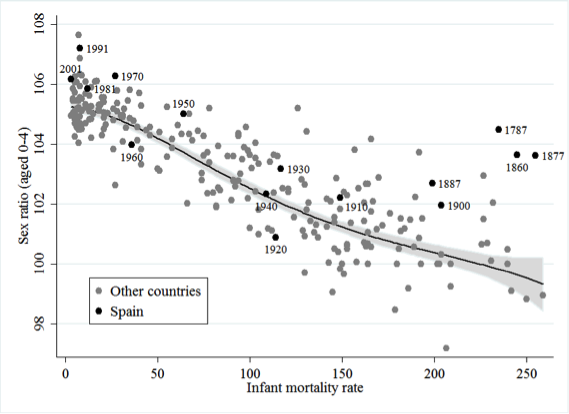Missing girls in 19th-century Spain
by Francisco J. Beltrán Tapia (Norwegian University of Science and Technology)
The full article, ‘What explains the missing girls in nineteenth‐century Spain?‘ was published by the Economic History Review.
—
Gender discrimination, in the form of sex-selective abortion, female infanticide and the mortal neglect of young girls, constitutes a pervasive feature of many contemporary developing countries, especially in South and East Asia and Africa. Son preference stemmed from economic and cultural factors that have long influenced the perceived relative value of women in these regions and resulted in millions of “missing girls”. But, were there “missing girls” in historical Europe? The conventional narrative argues that there is little evidence for this kind of gender discrimination. According to this view, the European household formation system, together with prevailing ethical and religious values, limited female infanticide and the mortal neglect of young girls.
However, several studies suggest that parents treated their sons and daughters differently in 19th-century Britain and continental Europe (see, for instance, here, here or here). These authors stress that an unequal allocation of food, care and/or workload negatively affected girls’ nutritional status and morbidity, which translated in worsened heights and mortality rates. In order to provide more systematic historical evidence of this type of behaviour, our research (with Domingo Gallego-Martínez) relies on sex ratios at birth and at older ages. In the absence of gender discrimination, the number of boys per hundred girls in different age groups is remarkably regular, so comparing the observed figure to the expected (gender-neutral) sex ratio permits assessing the cumulative impact of gender bias in peri-natal, infant and child mortality and, consequently, the importance of potential discriminatory practices. However, although non-discriminatory sex ratios at birth revolve around 105-106 boys per hundred girls in most developed countries today, historical sex ratios cannot be compared directly to modern ones.
We have shown here that non-discriminatory infant and child sex ratios were much lower in the past. The biological survival advantage of girls was more visible in the high-mortality environments that characterised pre-industrial Europe due to poor living conditions, lack of hygiene and the absence of public health systems. Subsequently, boys suffered relatively higher mortality rates both in utero and during infancy and childhood. Historical infant and child sex ratios were therefore relatively low, even in the presence of gender-discriminatory practices. This is illustrated in Figure 1 below which plots the relationship between child sex ratios and infant mortality rates using information from seventeen European countries between 1750 and 2001. In particular, in societies where infant mortality rates were around 250 deaths (per 1,000 live births), a gender-neutral child sex ratio should have been slightly below parity (around 99.5 boys per hundred girls).

Compared to this benchmark, infant and child sex ratios in 19th-century Spain were abnormally high (see black dots in Figure 1 above; the number refers to the year of the observation), thus suggesting that some sort of gender discrimination was unduly increasing female mortality rates at those ages. This pattern, which is not the result of under-enumeration of girls in the censuses, mostly disappeared at the turn of the 20th century. Notwithstanding that average sex ratios remained relatively high in nineteenth- century Spain, some regions exhibited even more extreme figures. In 1860, 54 districts (out of 471) had infant sex ratios above 115, figures that are extremely unlikely to have occurred by chance. Relying on an extremely rich dataset at the district level, our research analyses regional variation in order to examine what lies behind the unbalanced sex ratios. Our results show that the presence of wage labour opportunities for women and the prevalence of extended families in which different generations of women cohabited had beneficial effects on girls’ survival. Likewise, infant and child sex ratios were lower in dense, more urbanized areas.
This evidence thus suggests that discriminatory practices with lethal consequences for girls constituted a veiled feature of pre-industrial Spain. Excess female mortality was then not necessarily the result of ill-treatment of young girls but could have been just based on an unequal allocation of resources within the household, a circumstance that probably cumulated as infants grew older. In contexts where infant and child mortality is high, a slight discrimination in the way that young girls were fed or treated when ill, as well as in the amount of work which they were entrusted with, was likely to have resulted in more girls dying from the combined effect of undernutrition and illness. Although female infanticide or other extreme versions of mistreatment of young girls may not have been a systematic feature of historical Europe, this line of research would point to more passive, but pervasive, forms of gender discrimination that also resulted in a significant fraction of missing girls.
To contact the author:
francisco.beltran.tapia@ntnu.no
Twitter: @FJBeltranTapia

